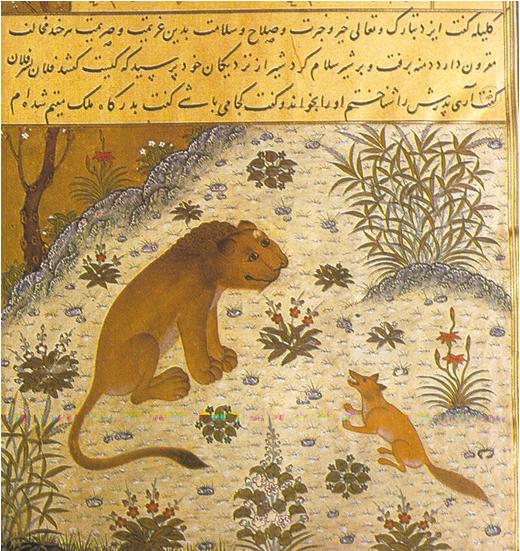The article below is by Lutz Richter-Bernburg. This originally appeared in the CAIS (Circle of Ancient Iranian Studies) venue. The CAIS site is hosted by Shapour Suren-Pahlav. Note that the article originally appeared in the Encyclopedia Iranica.
The version printed below is different in that it has embedded photographs and captions used in Kaveh Farrokh’’s lectures at the University of British Columbia’s Continuing Studies Division and were also presented at Stanford University’s WAIS 2006 Critical World Problems Conference Presentations on July 30-31, 2006.
==================================================================
GONDÊŠÂPUR (< Mid. Pers. Weh-Andiôk-Šâbuhr; Mid. Pers. Inscription: why-‘ndywk-Šhypwhry “Better Is Šâbuhr’s Antioch,” ŠKZ l. 32″; for the successive transformation of the Mid. Pers. form into subsequent Ar. Jondaysâbur, cf. the Gk. Bendosabora and Nöldeke’s observations on similar changes from Mid. Pers. /v/ to NPers. /g/), name of a Sasanian and post-Sasanian district and its urban center in Khhuzestân; its site has been located “south of the village of Šâhâbâd, three km below the last of the low ridges marking the northern limit of the Khuzestân plain” (Adams and Hansen, p. 53), between Tostar and Dezful (q.v.).
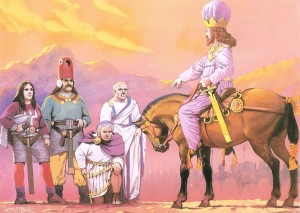
Emperor Valerian surrenders to Shapur I (241-272 CE) and Sassanian nobility at Edessa in 260 CE. Gundeshapur was founded by Shapur I on in 271 CE, just eleven years after Emperor Valerian’s surrender at Edessa (portrait by Angus McBridge for Farrokh text of 2005). Gundeshapur was a major learning, research and intellectual center of the Sassanian Empire (224-651 CE).
According to epigraphic, archeological, and literary evidence, the city owed its existence to the Sasanian Ardašir I’s son and successor, Šâpur I (r. 242-72). Following the long-established royal custom, Šâpur commemorated his role as founder (and possibly patron) in the new establishment’s name, including also a reference to his recent victory over the Roman emperor Valerian III (r. 253-60) by claiming superiority for his “Antioch” over the homonymous metropolis of Syria. Consequently, the date of Šâpur’s founding act is contingent on the much debated chronology of his Roman war(s) and conquests of Antioch-on-the-Orontes (see antioch). Even though the existence of the “parallel” Syriac name of Bêth Lâpât (q.v.) would seem to point to a previous settlement in the area, the archeological surface reconnaissance of 1963 (Adams and Hansen, p. 53), which in the absence of a systematic investigation of the site is our only archeological evidence, discovered no trace of a pre-Sasanian occupation. A literary echo of such occupation predating Šâpur is also found in the late Sasanian list of provincial capitals (Markwart, Provencial Capitals, pp. 20, 98, sec. 48) and in the (garbled) legendary account of Šâpur’s survey of the site in view of his intended foundation (Tabari, I, pp. 830-31, tr., V, pp. 38-39; Nöldeke,Geschichte der Perser, pp. 41-42, n. 2, tr. pp. 87-88, 99-100; Dinavari, ed. Guirgass, pp. 48-49, who mentions two corrupted forms, Nilât and Nilâb, of the original Aramaic name as the town’s name in Khuzi and in the language of its population, i.e., in Syriac; for the legend of Šâpur’s love for a Byzantine princess and the founding of Gondêšâpur on the model of Constantinople to please her, see Ebn al-QeftÂi, p. 133). The transparently etiological tendency of the report, as quoted by the Anonymous Berolinensis Sprenger 30 (see Tabari, tr., V, p. xxiii) on the one hand and Tabari on the other, would seem to discredit it as merely explaining the popular Persianized name Bêlâbâd, but the early attestation of the Aramaic form as byl’b’d and Bêlapat, in the Parth-ian and Coptic Manichean tradition respectively, would seem to indicate a historical nucleus of the later, embellished accounts, given the fact that in the Sasanian-Arabic tradition, Mani’s imprisonment and death was well-nigh unanimously located in Gondêšâpur (Nöldeke, pp. 42, n., 47 and n. 5).

Gundeshapur was repaired and expanded by Shapur II (310-379 CE). The site may have served as Shapur II’s second capital.
The architectural remains on the ground permit us to trace an orthogonal street grid within an oblong rectangular walled enclosure, thus approximating Hamza Esfahâni’s idealized description of the site’s layout as a chessboard of eight by eight streets (p. 49, ll. 7-9). In addition, primary sources, such as inscriptions and bullae, attest Gondêšâpur only at the beginning and during the last few decades of the Sasanian period; to date, its history in the later centuries are documented archeologically primarily by ceramic finds from the above-mentioned surface reconnaissance. These, casting substantive doubt on the literary evidence, clearly point to the site’s rapid decline after the late 9th century. Consequently, the geographers of the 10th and subsequent centuries (e.g., Estakhri, p. 93; Maqdesi/Moqaddasi, p. 405) would appear to have derived their information on the site’s continued prosperity from uncritical compilations of older texts rather than from autopsy or contemporaneous records (Adams and Hansen, pp. 57-59).
Šâpur’s official record of the satrapy of Weh-Andiyôk-Šâbuhr in his famous trilingual inscription at Ka’ba-ye Zardošt (ŠKZ) near Persepolis is paralleled in Sasanian narrative historiography as transmitted to, and partially preserved by, later Arabic and Persian authors; thus he is credited with the establishment of both district and city of Gondêšâpur (Tabari, I, pp. 830-831; Ya’qubi, Ta’rikh I, p. 180). Tabari as well as Hamza (pp. 48-49), or perhaps their common source, even undertook to explain the city’s name as deriving from Persian Beh-az-Andiu-Šâpur; in spite of the obvious interpolation of the word “az,” their attempt deserves recognition for the correct identification of the main elements of the name: “weh” and “Andiôk.” Also, the possibility of contamination by a later Sasanian pattern of toponymy as exemplified by Weh-az-Âmid-Kawâd remains to be considered (see Gyselen 1989, p. 62, no. 47; cf. Weh-Ârdašir and Weh-Kawâd, ibid., pp. 61-62, nos. 46, 48). The terminus post quem of Šâpur’s foundation was his occupation of Antioch. However, he conquered the city twice within a few years, the earlier one was arguably in 256 (according to the patriarch Nicephorus, Demetrianus’s patriarchate in Antioch began in 253 and lasted altogether four years; see Schwaigert, pp. 20-23) and the later one in 260, during Valerian III’s fateful campaign. If the report of Demetrianus’s deportation from Antioch and his incumbency as bishop of Gondêšâpur in the Chronicle of Se’ert (Patrologia Orientalis IV/3, p. 221) is accepted, the date of Šâpur’s foundation would fall into the period between his two occupations of Anitoch, i.e., the years 256-60.
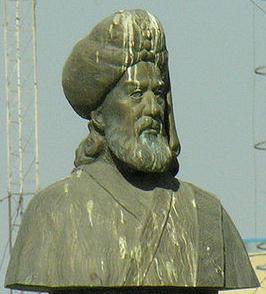 A statue of Burzoe -برزويه- at Isfahan. Also known as Bozorg-Mehr-بزرگمهر– Burzoe was was the vizier of Khosrau I Anoushirvan (r. 531-579 CE) and physician during the late Sassanian Empire of the sixth century. He is well known for having translated India’s Panchatantra from its original Sanskrit into Pahlavi (Middle Persian). Unfortunately both the original Panchatantra and its Pahlavi translation were lost in time, but the Pahlavi version was translated into Arabic by Ibn al-Mafuqqa. The Arabic version is known as the Kalila and Dimna. it is also noteworthy that Burzoe was an accomplished sage in chess.
A statue of Burzoe -برزويه- at Isfahan. Also known as Bozorg-Mehr-بزرگمهر– Burzoe was was the vizier of Khosrau I Anoushirvan (r. 531-579 CE) and physician during the late Sassanian Empire of the sixth century. He is well known for having translated India’s Panchatantra from its original Sanskrit into Pahlavi (Middle Persian). Unfortunately both the original Panchatantra and its Pahlavi translation were lost in time, but the Pahlavi version was translated into Arabic by Ibn al-Mafuqqa. The Arabic version is known as the Kalila and Dimna. it is also noteworthy that Burzoe was an accomplished sage in chess.
Documentation of Weh-Andiôk-Šâbuhr’s subsequent history under Sasanian rule is very uneven. The relative prominence of Christians in the region is attested by the Chronicle of Se’ert, which mentions the election of a certain Ardaq as the episcopal successor to Demetrianus, thus adumbrating the later importance of Bê(th) Lâpât as the metropolitan see of Bêth H¨uzâyê (Schwaigert, passim). According to the literary tradition, Weh-Andiôk-Šâbuhr repeatedly fulfilled the function of royal residence during the 3rd and 4rth centuries, at least un-til the great persecution of Christians under Šâpur II. The earliest relevant witness is that of the Manichean tradition of Mani’s doomed confrontation with King Warahrân I and his counselors at ‘Bêlapat’ and his ensuing fatal imprisonment there in 276-77 (Dinavari, ed. ‘Âmer and Šayyâl, p. 47). The next firm date is furnished by the Syriac witnesses to Šâpur II’s persecution of Christians; in the decade of 340, the Catholicos Šâhdôst and others were tried there in the king’s presence and executed (Schwaigert, p. 110). Thus the city must have retained some of its former standing even after Šâpur moved residence from Gondêšâpur after the first thirty years of his reign, if Hamza (p. 52) is lent credence, and the coincidence of this date with the (re-)foundation of Karkhâ dhe Lêdhân as Xwarrah Šâbuhr in 338 would seem to support it (cf. Schwaigert, pp. 109-10; thus Gyselen’s attractive hypothesis, p. 75, against Hamza, p. 52, who cites Xwarrah Šâbuhr as Susa’s name and, among Šâpur II’s foundations, refers to an unnamed town near Sus that the author of Mojmal al-tawârikh
New Persian text of Kalileh va Damneh, produced in Herat in 1429.
Sasanian rule at Gondêšâpur ended with the city’s surrender to the Muslim forces in 17/638 (Tabari, I, pp. 2566-68, tr., XIII, pp. 146-49; Ebn al-Athir, Beirut, II, p. 553). This event, as well as the city’s subsequent history, are well-documented by narrative sources, with the notable exception of the archeological evidence mentioned above. Gondêšâpur figures in the geographic literature of the 9th and following centuries, but in political history it recaptures attention only once, and then briefly, in the latter part of the 9th century. In 262/875-76, in the course of the successive challenges to caliphal authority, one of the contending leaders, Ya’qub b. Layth Saffâr, made Gondêšâpur his residence; whatever further ambitions he may have had were, however, cut short by his sudden death in 265/879. His grave there became one of the city’s sites for its remaining span of existence (Estakhri, p. 93; Ebn Hawqal, p. 256; Mas’udi, Tanbih, p. 368; idem, Muruj, ed. Pellat, sec. 601; Târikh-e Sistân, p. 233; Ebn Khallekân, tr. de Slane, IV, pp. 320-22; Hodud al-‘âlam, ed. Sotuda, p. 139, tr. Minorsky, pp. 131, 381-82). During the following century and a half, Gondêšâ-pur gradually faded out of history, although the literary tradition would have it otherwise.
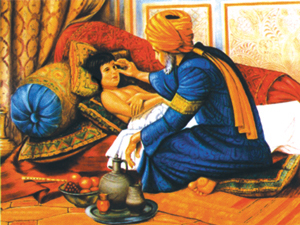 Iranian physician, philosopher and religious critic Zacharia Razi (Rhazes) (860- 923 or 932) born in Rayy (near Tehran), Iran. Razi Produced two standard Medical texts: Kitab al-Mansuri and the Kitab al-Hawi. He also is known to have produced the first Treatise on Small Pox and Measles and for his use of Animal Gut for Sutures and the Plaster of Paris for Casts.
Iranian physician, philosopher and religious critic Zacharia Razi (Rhazes) (860- 923 or 932) born in Rayy (near Tehran), Iran. Razi Produced two standard Medical texts: Kitab al-Mansuri and the Kitab al-Hawi. He also is known to have produced the first Treatise on Small Pox and Measles and for his use of Animal Gut for Sutures and the Plaster of Paris for Casts.
Gondêšâpur’s real fame in the history of Islamic Persia rests on its alleged role in the transmission of Hellenistic learning, or more precisely, of Galenic medicine and the institution of the teaching hospital (bimârestân) to the metropolitan ‘Abbasid society and beyond that to Islamic civilization at large (see BÈMÂRESTÂN and BOKhTÈŠUu‚’ iv, pace Dols, esp. pp. 381-85). The earliest testimony to Gondêšâpur in the context of medical learning refers to a medical-philosophical disputation convened on Khosrow II’s orders in about 610, in which the drustbed (q.v.) Gabriel of Šiggâr participated; the hospital itself first finds specific mention in the events of the year 148/765, when the caliph al-Mansur is said to have summoned the then head of Gondêšâpur’s hospital, Jewarjis b. Jebrâ’il b. Bokhtišu’, to Baghdad (Ebn al-QeftÂi, pp. 158-60). In spite of the dearth of detailed and reliable information about local and regional conditions in the pre-‘Abbasid periods, Khhuzestân and in particular the city of Gondêšâpur must be considered the locale where Syro-Persian Nestorians were weaned on what the later biobibliographical authors celebrated as superior medical learning. The information found in narrative sources concerning the derivation of such knowledge during the Sasanian period from outstanding individual Greek and Indian sources, as well as from the local Aramaic and Iranian roots, (see BOKhTIŠU’ and Aydén Saylé, p. 1120) has substantially been corroborated by the extant texts themselves, however limited their scholarly horizon indubitably is. The differential which in the first ‘Abbasid decades obtained between Nestorian medical competence and that of society at large was sufficient to launch the Bokhtišu’ family and others onto a brilliant career in the orbit of the ‘Abbasid court (cf. Jâhez, pp. 109-10; idem, apud Dols, p. 382). Moreover, they rose to the challenge and successively improved their theoretical and practical command of the discipline, not least by rediscovering and eventually passing on to the Muslims, Galen and the other classics of Hellenistic medicine.
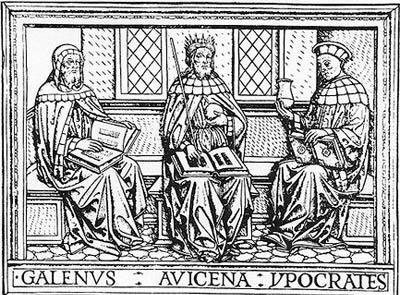 A medieval portrait of the sages of medicine: Galen (left), the Iranian Avicenna (center) and Hippocrates (right). (980 -1037). Avicenna (or Abu Ali Sina) was born in Afshana, near (Bukhara), the ancient capital of the Iranian Samanid dynasty. The Arab Scholar Al-Qitfi has noted that “They (the Persians) made rapid progress in science, developing new methods in the treatment of disease along pharmacological lines so that their therapy was judged superior to that of the Greeks and Hindus” (as cited in Elgood, 1953, p.311, Legacy of Persia (edited by AJ. Arberry), Clarendon Press).
A medieval portrait of the sages of medicine: Galen (left), the Iranian Avicenna (center) and Hippocrates (right). (980 -1037). Avicenna (or Abu Ali Sina) was born in Afshana, near (Bukhara), the ancient capital of the Iranian Samanid dynasty. The Arab Scholar Al-Qitfi has noted that “They (the Persians) made rapid progress in science, developing new methods in the treatment of disease along pharmacological lines so that their therapy was judged superior to that of the Greeks and Hindus” (as cited in Elgood, 1953, p.311, Legacy of Persia (edited by AJ. Arberry), Clarendon Press).
As regards the Gondêšâpur hospital, which for several generations was under Bokhtišu”s direction and presumably the city’s only such institution, the sources provide only scattered information on how it fared after the Bokhtišu’ finally moved to Baghdad (Dols, pp. 377, 381-82); specifically, the question is whether the death of the last known director, Sâbur b. Sahl, in 255/869 (Ebn al-QeftÂi, p. 207), also spelled the end of the hospital itself.
Primary Sources
Robert McC. Adams and Donald P. Hansen, “Archaeological Reconnaissance and Soundings in Jundi Shâhpur,” Ars Orientalis 7, 1968, 53-70, with appendix by Nabia Abbott, “Jundi Shâhpur: A Preliminary Historical Sketch,” pp. 71-73.
Friedrich Carl Andreas and Walter Bruno Henning, Mitteliranische Manichaica aus Chinesisch-TurkestanIII, SPAW, Phil-hist. Kl., Berlin 1934, pp. 848-912, esp. p. 861, ll. 26 f.; repr. in Walter B. Henning, W. B. Henning Selected Papers, Acta Iranica 14, Leiden, 1977, pp. 275-340.
Chronicle of Se’ert, ed. and tr. Addai Ibrahim Scher and Jean Perier, in Patrologia Orientalis, Paris, 1908-50: IV/3, pp. 219-313; V/2, pp. 241-334; VII/2, pp. 99-203; XIII/2, pp. 437-639.
Sarah Clackson et al., Dictionary of Manichaean Texts I: Texts from the Roman Empire (Texts in Syriac, Greek, Coptic and Latin), Corpus Fontium Manichaeorum Subsidia, Ancient History Documentary Research Center, Macquarie University, Brepols and Sydney, 1998, p. 182, s.v. Bhlapat.
Abu Hanifa Dinavari, Ketâb al-akhbâr al-tewâl, ed. V. Guirgass, Leiden, 1888, esp. pp. 48-49, 71, 75; ed. ‘Abd-al-Mon’em ‘Âmer and Jamâl-al-Din Šayyâl, Cairo, 1960, pp. 46, 47.
Ebn al-QeftÂi, Ta’rikh al-hokamâ’, ed. Julius Lippert, Leipzig, 1903.
Philippe Gignoux, Catalogue des sceaux, came‚es et bulles sasanides de la Bibliotheàques nationale et du Muse‚e du Louvre II, Les sceaux et bulles inscrits, Paris, 1978, p. 117, nos. 13.1-2., Pl. LXVI, no. 13.
Rika Gyselen, “Ateliers mone‚taires et cachets officiels sasanides,” Stud. Ir. 8/2, 1979, pp. 189-212.
Idem, La geographie administrative de l’Empire Sassanide: les te‚moignages sigillographiques, Paris, 1989, esp. p. 61.
Philip Huyse, Die dreisprachige Inschrift Šâbuhrs I. an der Ka’ba-i Zardušt (ŠKZ), 2 vols., Corpus Inscriptionum Iranicarum, pt. III Pahlavi Inscriptions I: Royal Inscriptions, London, 1999, esp. I, p. 58, sec. 46; II, pp 156-57.
Abu ‘Othmân ‘Amr b. Bahr Jâhez, Ketâb al-bokhalâ’/Livre des avares, ed. Gerlof van Vloten, Leiden, 1900.
Procopius, De bello Gothico 8:10.9. Theophylactus Simocatta, Historiae 3.5; tr. Peter Schreiner asGeschichte, Bibliothek der griechischen Literatur 20, Stuttgart, 1985, p. 93.
Aydén Sayélé, “Gondêshâpur,” in EI2 II, p. 1120.
Secondary Sources
Michael W. Dols, “The Origins of the Islamic Hospital: Myth and Reality,” Bulletin of the History of Medicine 61, 1987, pp. 367-90.
Jean Maurice Fiey, “L’Élam, la premieàre des me‚tropoles eccle‚siastiques syriennes orientales,” Melto 5, 1969, pp. 221-67; repr. in idem, Communaute‚s syriaques en Iran et Irak des origines aà 1552, Variorum Reprints, London, 1979, no. IIIa.
Theodore Nöldeke, Geschichte der Perser, esp. pp. XXI, 40-42; tr. ‘Abbâs Zaryâb Kho’i as Târikh-e Irâniân wa ‘Arabhâ dar zamân-e Sâsâniân, Tehran, 1358 Š./1980.
Paul Peeters, “S. De‚mëtrianus e‚vêque d’Antioche?” Analecta Bollandiana 42, 1924, pp. 288-314.
Wolfgang Schwaigert, “Das Christentum in Khuzistân im Rahmen der frühen Kirchengeschichte Persiens bis zur Synode von Seleukeia-Ktesiphon im Jahre 410,” Ph.D. Diss., Philipps Üniversität, Marburg, 1989, esp. pp. 27-33

